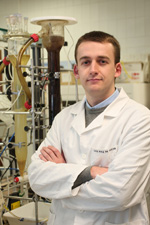Un químico de la Universidad de Navarra propone el uso de microondas en el procesado de conservas vegetales
A chemist from the University of Navarra proposes the use of microwaves in the processing of canned vegetables
This technology, which would replace traditional blanching, saves energy and water, reduces waste, and maintains the characteristics of the subject raw material.

"Microwave blanching is a clean technology that presents interesting advantages for its possible installation in the agri-food industry, compared to conventional blanching systems", explains chemist Luis Ruiz de Ojeda. This is one of the main conclusions of his thesis , defended at the School of Sciences of the University of Navarra.
The goal of work was to study an emerging clean technology - microwave (EM) blanching - in the processing of chard, artichoke, borage, cardoon and green beans, to replace traditional blanching, "a thermal operation widely used in the production of canned vegetables, which consumes large amounts of energy and resource water, and generates large volumes of waste," explains the author.
According to the scientist, microwave blanching can be used to obtain subject raw material with stable physical properties, with texture and color characteristics similar to those that would be obtained with conventional blanching, and with better nutrient retention.
Study of time and power on the characteristics of the product
The work consisted of studying the effect of treatment time and power, as well as operating load on temperature, weight loss, size reduction, enzymatic activity, texture, color and ascorbic acid (vitamin C).
For example, the results concluded that with EM the vegetables experience an increase in temperature, weight loss and enzymatic inactivation proportional to the intensity of the treatment. Likewise, the dimensions of the raw subject show a strong initial reduction, but no significant variations are appreciated in prolonged operation times.
It was also found that for mild conditions, vegetables undergo a slight increase in the firmness of their tissues; however, as the treatment is prolonged, vegetables become progressively softer.
Luis Ruiz de Ojeda emphasizes that by means of EM it is possible to obtain green beans, artichoke, cardoon and borage with the enzymatic machinery inactive, and with texture and color characteristics similar to those of the product currently obtained in a cannery business . "For optimum blanching conditions, ascorbic acid retention is similar and even higher, and weight loss is reasonable from a cost-effectiveness standpoint. It also takes less time than conventional blanching," he concludes.
Additionally, the modeling of the experimental data was performed, obtaining satisfactory results. However, the author indicates that further programs of study are needed to evaluate microwave scalding on an industrial scale and in real cases.
